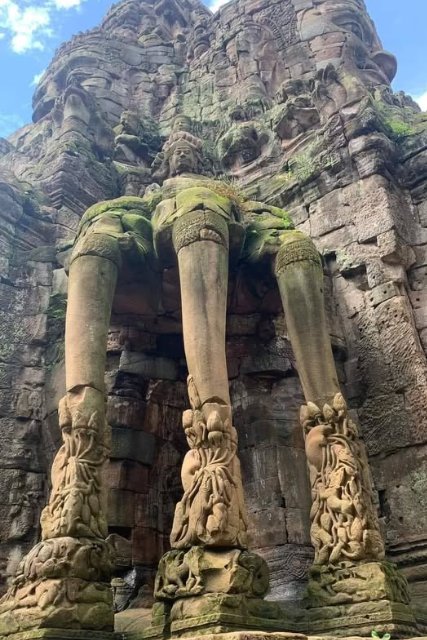When you visit **Angkor Thom**, one of the most iconic archaeological sites in Cambodia, you are not merely stepping through an entrance. The **Gate of Angkor Thom** is much more than a physical gateway; it serves as a portal back in time, transporting visitors to the grandeur and mystery of the **Khmer Empire**. This magnificent structure, part of the larger Angkor Archaeological Park, offers an awe-inspiring glimpse into Cambodia’s glorious past and its architectural brilliance.

### What Is Angkor Thom?
**Angkor Thom** is a majestic ancient city that once served as the capital of the **Khmer Empire**, which flourished between the 9th and 15th centuries. Located in present-day **Siem Reap**, Cambodia, the city covers an impressive area of over 9 square kilometers. Its most famous feature is the **Angkor Thom Gate**, a series of monumental entrances that lead into the ancient city.

The gates are an architectural marvel, each with distinct features and rich symbolism. The main gate, known as the **Victory Gate**, is one of the most iconic, but there are also four other gates, each positioned at strategic points of the city. These gates represent not just a physical entry to the city but also a journey through history and culture.
### The Intricate Architecture of Angkor Thom Gate
The **Angkor Thom Gate** stands as a stunning example of Khmer architectural ingenuity. Constructed from sandstone, each gate is flanked by massive stone statues that depict deities, kings, and celestial figures. The most notable feature of the gates is the imposing **stone faces** that tower over the visitors. These faces are believed to represent **Avalokiteshvara**, the Buddhist deity of compassion, or possibly the king himself, **Jayavarman VII**, who commissioned the construction of the city and the gates.

The **gate’s design** is highly symbolic. The faces are positioned to represent the **four cardinal directions**, with each face symbolizing the virtues of the divine protector: wisdom, power, and compassion. The **elephant-headed figures** and other mythological motifs adorning the gates reflect the deep spiritual and cultural significance of these monuments.
### The Symbolism of the Gate of Angkor Thom
Beyond its architectural beauty, the **Gate of Angkor Thom** holds deep cultural and spiritual symbolism. The gates are designed not only as protective structures but also as symbolic thresholds, representing the transition from the mortal world to the divine. The massive stone faces on the gates are thought to represent the protective deities of the city, watching over the inhabitants and ensuring their safety from external threats.
The procession of statues that line the gates, known as the **churning of the ocean of milk**, is a representation of an ancient Hindu myth. The statues, which include gods and demons, are shown pulling a giant serpent. This mythological scene symbolizes the cosmic struggle between good and evil and the ultimate balance between these forces.
### The Historical Significance of Angkor Thom
Angkor Thom was built during the reign of **Jayavarman VII**, one of the most notable rulers of the **Khmer Empire**. Under his leadership, the empire expanded to its zenith, and Angkor Thom became the heart of this prosperous civilization. The city was not only a political capital but also a center of culture, religion, and trade.
The **Gate of Angkor Thom**, like the city itself, is a representation of the power and grandeur of the Khmer Empire. It was carefully designed to symbolize the empire’s might and its dedication to both Buddhist and Hindu traditions. The city’s design reflects cosmic order, with the gates serving as portals that connect the human world to the divine.
### Visiting the Gate of Angkor Thom: A Journey Back in Time
Today, the **Gate of Angkor Thom** continues to mesmerize visitors from around the world. Stepping through its towering stone structure is like entering a time machine, offering a direct connection to the ancient world of the Khmer Empire. As you pass under the massive stone faces and through the sacred gates, you are transported to a time when Angkor Thom was a bustling metropolis filled with temples, palaces, and sacred rituals.
The experience of visiting the gates is made even more profound by the surrounding natural beauty. The lush greenery and tranquil surroundings of the **Angkor Archaeological Park** provide a serene backdrop to the grandeur of the gates. The park, which includes other famous temples such as **Angkor Wat**, offers visitors a chance to explore the full legacy of the Khmer civilization.
### The Cultural Legacy of Angkor Thom
The **Gate of Angkor Thom** is a symbol of Cambodia’s rich cultural heritage and the enduring legacy of the **Khmer Empire**. Although the empire itself eventually fell to invaders, the magnificence of Angkor Thom and its gates remain intact as a testament to the artistic and architectural achievements of the Khmer people.
Angkor Thom and its gates are not just tourist attractions; they are also an essential part of Cambodia’s national identity. As Cambodia faces the challenges of modern development, the preservation of these ancient structures serves as a reminder of the nation’s deep history and spiritual traditions.
### A Portal to the Past
The **Gate of Angkor Thom** is far more than just an architectural feature—it is a living testament to the greatness of the Khmer Empire. Walking through its monumental structure feels like stepping into another era, allowing visitors to connect with the spiritual, cultural, and political significance of Angkor Thom. For anyone interested in history, architecture, and culture, the Gate of Angkor Thom is truly a **portal back in time**, offering a glimpse into one of the most impressive civilizations the world has ever known.
By exploring the magnificent **Gate of Angkor Thom**, you are not just visiting a historic site; you are experiencing the ancient Khmer legacy that has shaped Cambodia’s identity for centuries. Don’t miss the chance to step through this doorway to the past and immerse yourself in the grandeur of **Angkor Thom**.
